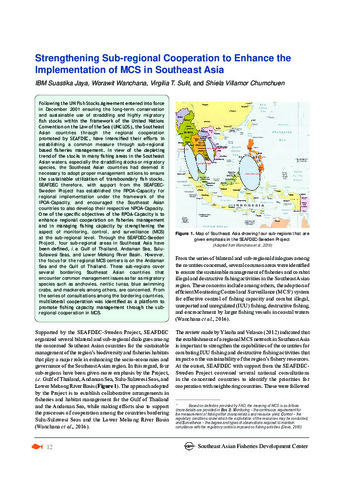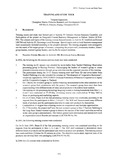Perlihatkan publikasi sederhana
Strengthening sub-regional cooperation to enhance the implementation of MCS in Southeast Asia
Share
| dc.contributor.author | Jaya, IBM Suastika | |
| dc.contributor.author | Wanchana, Worawit | |
| dc.contributor.author | Sulit, Virgilia T. | |
| dc.contributor.author | Chumchuen, Shiela Villamor | |
| dc.date.accessioned | 2019-05-21T03:57:11Z | |
| dc.date.available | 2019-05-21T03:57:11Z | |
| dc.date.issued | 2019 | |
| dc.identifier.uri | http://hdl.handle.net/20.500.12066/4810 | |
| dc.description.abstract | Following the UN Fish Stocks Agreement entered into force in December 2001 ensuring the long-term conservation and sustainable use of straddling and highly migratory fish stocks within the framework of the United Nations Convention on the Law of the Sea (UNCLOS), the Southeast Asian countries through the regional cooperation promoted by SEAFDEC, have intensified their efforts in establishing a common measure through sub-regional based fisheries management. In view of the depleting trend of the stocks in many fishing areas in the Southeast Asian waters, especially the straddling stocks or migratory species, the Southeast Asian countries had deemed it necessary to adopt proper management actions to ensure the sustainable utilization of transboundary fish stocks. SEAFDEC therefore, with support from the SEAFDECSweden Project has established the RPOA-Capacity for regional implementation under the framework of the IPOA-Capacity, and encouraged the Southeast Asian countries to also develop their respective NPOA-Capacity. One of the specific objectives of the RPOA-Capacity is to enhance regional cooperation on fisheries management and in managing fishing capacity by strengthening the aspect of monitoring, control, and surveillance (MCS) at the sub-regional level. Through the SEAFDEC-Sweden Project, four sub-regional areas in Southeast Asia have been defined, i.e. Gulf of Thailand, Andaman Sea, Sulu-Sulawesi Seas, and Lower Mekong River Basin. However, the focus for the regional MCS centers is on the Andaman Sea and the Gulf of Thailand. These sub-regions cover several bordering Southeast Asian countries that encounter common management issues as far as migratory species such as anchovies, neritic tunas, blue swimming crabs, and mackerels among others, are concerned. From the series of consultations among the bordering countries, multilateral cooperation was identified as a platform to promote fishing capacity management through the subregional cooperation in MCS. | en |
| dc.language.iso | en | en |
| dc.publisher | Secretariat, Southeast Asian Fisheries Development Center | en |
| dc.subject | South East Asia | en |
| dc.title | Strengthening sub-regional cooperation to enhance the implementation of MCS in Southeast Asia | en |
| dc.type | magazineArticle | en |
| dc.citation.volume | 17 | |
| dc.citation.issue | 1 | |
| dc.citation.spage | 12 | |
| dc.citation.epage | 18 | |
| dc.citation.journalTitle | Fish for the People | en |
| dc.subject.asfa | resource management | en |
| dc.subject.asfa | fishery management | en |
| dc.subject.asfa | Environment management | en |
| dc.subject.asfa | natural resources | en |
| dc.subject.asfa | resource conservation | en |
| dc.subject.asfa | Surveillance and enforcement | en |
| dc.subject.asfa | International law | en |
| dc.subject.asfa | environmental legislation | en |
| dc.subject.asfa | Ocean policy | en |
| dc.subject.asfa | Fishery policy | en |
| dc.subject.asfa | stocks | en |
| dc.subject.asfa | international cooperation | en |




